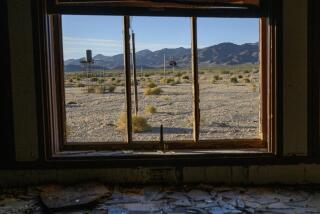U.S. Areas May Be 1st Victims of Warming Earth
The Midwest farm belt and the southeastern United States will be among the first regions of the Earth to feel the effects of “greenhouse” warming caused by the release of carbon dioxide and other gases into the atmosphere, according to predictions of a new computer model of the atmosphere developed at the NASA-Goddard Institute for Space Studies in New York City.
The model allows scientists, for the first time, to predict the effects of greenhouse warming over the next 10 to 20 years rather than 50 to 70 years in the future, as is the case with previous models, according to atmospheric physicist Anthony Del Genio of Goddard.
California Gets a Reprieve
By identifying which regions will be first to warm up, the model may enable scientists to observe the first stages of the greenhouse effect and give them a better idea of how to deal with it. Other regions of early warming predicted by the model include the East Indies, the Bay of Bengal in India, the Mongolian-Manchurian region of Asia and both polar regions.
The model also predicts that California and the Pacific Coast will be among the last regions to be affected by greenhouse warming, lagging behind the rest of the country by perhaps 25 years.
Surprisingly, the model also predicts that even in the highly unlikely event that the release of carbon dioxide and other so-called greenhouse gases were to be halted immediately, the Earth would continue to grow warmer for at least 15 years. “It takes the Earth a while to respond to the gases that are already there,” Del Genio said.
The computer model was developed by a team led by climatologist James E. Hansen and is described in the current Journal of Geophysical Research--Atmospheres.
Hansen made national headlines in June when he told a Senate committee that the heat and drought afflicting the Midwest represented the first stages of the greenhouse effect. That conclusion was based on both the computer model and the observation that four of the hottest years on record have occurred during the 1980s.
Many other researchers argue that the drought was caused by normal climatic variability rather than by the greenhouse effect. But few would question the conclusion that greenhouse warming is imminent.
The climatological effects of carbon dioxide and similar gases have been recognized since the late 1800s. Such gases allow the sun’s light to reach the Earth’s surface and warm it, but absorb heat that would otherwise be radiated into space--thus trapping heat just like the glass panes of a greenhouse.
The amount of carbon dioxide in the Earth’s atmosphere has grown from about 270 parts per million in the mid-1800s to about 350 parts per million now. A 1983 National Academy of Sciences report predicted that the level could reach 600 parts per million within 50 to 100 years if the use of fossil fuels continued to grow at then-current rates.
Climatologists estimate that the Earth’s surface temperature has already increased between 0.5 and 1.25 degrees Fahrenheit since 1850. Previous projections have estimated a warming of as much as 9 degrees in the next 100 years.
Such warming could cause a marked change in weather patterns, including a northward shift of precipitation. It could also cause a melting of the polar icecaps, accompanied by an increase in the oceans’ level and coastal flooding.
Hansen and his colleagues used their model to study three different scenarios: continued rapid growth in the release of greenhouse gases; curtailed growth of release rates and no increase in release rates.
In the first case, they calculated that the Earth’s temperature would rise by 1.6 degrees Fahrenheit in the next 20 years. If growth in release rates were curtailed, 25 years would be required for a similar temperature increase.
And even with no increase in growth rates, the average global temperature would probably climb by 0.8 degrees within the next 15 years, they said. That increase would bring the Earth’s temperature to the peaks reached during the Altithermal and Eemian periods 6,000 and 120,000 years ago.
The model identified regions of early warming by characterizing interactions between the oceans, which warm very slowly, and land, which warms much more rapidly. In the United States, for example, these effects combine to produce high-pressure regions off the Atlantic and Pacific coasts.
Because winds flow clockwise around a high-pressure region, they would bring warm air from equatorial regions into the Southeast and Midwest. Similar winds around the Pacific high would bring cool Arctic air to California.
In each of the three scenarios, the researchers wrote, greenhouse warming “should be clearly identifiable in the 1990s.” And for the first two cases, the predicted warming rate of about 0.9 degrees per decade is a much faster change than any in the historical record, they said. “There may not be sufficient time for many biosystems to adapt to the rapid changes forecast. . . ,” they wrote.
The researchers also warned that the frequency of extreme weather events could be more dangerous to the biosphere than the increase in average temperature. They note, for example, that Omaha, Neb., has experienced a run of at least five days with temperatures above 95 degrees only three times per decade, on average. The model predicts that the number will increase to five times per decade in the 1990s and seven times per decade by 2020.
Such runs of high temperature are very damaging to both crops and humans, Hansen warned.
WHERE WARMING WILL OCCUR FIRST Antarctica
Artic
Midwest and Southeast United States
Caribbean
East Indies
Bay of Bengal
Central China
Mongolia and Manchuria
GLOBAL TEMPERATURE CHANGE Observed changes in the world’s temperature since 1960 and projected changes through the year 2020 as a result of the greenhouse effect. Scenario A assumes continued growth in the rate of release of carbon dioxide and similar gases. Scenario B assumes the implementation of some controls on the release of greenhouse gases, and scenario C assumes a complete halt in their release. Even under scenario C, temperatures would still climb into the shaded area, which represents the average temperatures during extremely warm periods about 6,000 and 120,000 years ago.
Source: NASA-Goddard Institute for Space Studies






